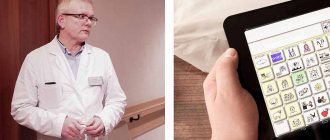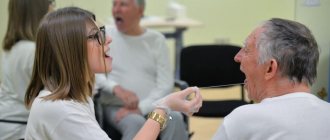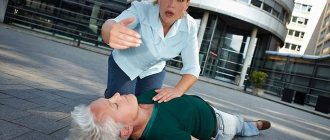Aphasia is a disorder characterized by disruption of previously normal speech. Aphasia can manifest itself to a greater or lesser extent. The person ceases to understand what is said to him and cannot speak himself. The manifestations of this disorder may vary in each case.
- Causes
- Classification of aphasia
- Manifestations of the disorder
- Diagnostics
- Aphasia correction
- Communication Guide
- Prognosis and prevention
Speech symptoms of aphasia:
- paraphasia
- speech emboli
- contamination
- perseveration
- acalculia
- agraphia
- alexia
- logorrhea, etc.
If this disorder is suspected, an examination of function, mental processes and neurological status is necessary. Aphasia is mainly a secondary disorder. That is, it is caused by a certain pathology, the elimination of which also relieves speech symptoms. Training is also necessary to restore speech skills after getting rid of the primary pathology.
Aphasia occurs due to organic damage to the areas of the human brain that are responsible for speech. There is a separate disorder called alalia. Aphasia differs from it in that a person’s speech is initially normal, he can understand phrases addressed to him and normally pronounces what he wants himself. And with alalia, a person cannot form normal speech skills from the very beginning.
Speech impairment in patients with aphasia is characterized as systemic. They are impaired:
- impressive (including understanding and perception),
- expressive (which includes grammar rules, vocabulary, pronunciation of sounds),
- written,
- inner speech.
Also with aphasia the following are affected:
- mental processes
- personality
- motor functions
- sensory sphere
For the reasons described above, aphasia is a complex disorder. It is studied by medical psychologists, speech therapists and neurologists.
Peculiarities
Motor aphasia is brain damage in Broca's area, which is characterized by irreversible organic changes in brain tissue with a complete loss of its functional activity in this area. Experts distinguish two main clinically significant forms of motor aphasia: afferent and efferent motor aphasia. With this disease, there is a disruption of the synthetic activity of the brain with loss of speech function, together with its perception. In this case, the patient has no situational speech, i.e. the patient cannot maintain a dialogue because he simply does not perceive it.
Afferent motor aphasia
Afferent or kinesthetic aphasia is manifested by difficulty in reproducing speech, mainly due to problems in the articulatory apparatus. Thus, patients with afferent motor aphasia cannot and cannot connect their own speech into a complete structured sentence.
Patients often try to replace words that they cannot pronounce with synonyms, which leads to a significant slowdown in spoken speech. The difficulty in pronouncing consonant sounds also attracts attention.
In most cases, afferent motor aphasia is combined with agraphia, a writing disorder.
Efferent motor aphasia
It occurs as a result of damage to the premotor areas of the cerebral cortex. Efferent motor aphasia manifests itself by literally jamming the patient’s speech on specific sounds. The patient cannot change the position of the articulatory apparatus, which leads to large time pauses between pronounced sounds. Speech becomes telegraphic or stamped.
It is worth noting that in almost half of all cases of identified motor aphasia in patients, a combination of both afferent and efferent aphasia occurs. Mixed aphasia is manifested by a complex manifestation of all of the above manifestations, which is called the term sensorimotor speech disorder.
Manifestations of the disorder
In a patient with any type of aphasia, speech in general is impaired. A person, when speaking, swaps syllables and individual sounds; literal paraphasias, perseverations, and also contaminations are characteristic. A person begins to make abnormally long pauses between words and phrases. There is hypophonia, that is, a voice similar in volume to a whisper. The rhythm and melody of speech are also impaired in aphasia. If a person develops an efferent motor type of disorder, he pronounces certain sounds normally.
Since reading and writing are impaired in the disorder in question, phenomena such as dysgraphia (the extreme form of which is agraphia) and dyslexia (the extreme form is alexia) are observed. With dysgraphia, a person does not write in capital letters; everything is written urgently. The handwriting of such a person is difficult to understand. He makes many mistakes when writing. Children with this disorder have an extremely difficult time with dictations.
With agraphia, the patient's intellect is preserved, but he cannot write. The cause should be differentiated from hand coordination disorders. With agraphia, a person misses words, cannot combine letters and syllables with each other, and grossly distorts words when writing. Dyslexia to the inability of a person to read, while the patient’s other cognitive abilities are normal.
With afferent motor aphasia, there can be 2 development options. First: there is a speech embolus, there is no spontaneous speech, or articulatory apraxia is recorded. Second: situational speech is normal, but voluntary speech is difficult or completely absent. Secondary processes of hearing impairment are typical for the afferent subtype of motor aphasia. Writing also suffers.
Acoustic-gnostic or sensory aphasia is characterized by the following manifestations:
- normal physical hearing
- impairment of auditory perception of phrases and sentences
Symptoms of Wernicke's aphasia:
- lack of control over one's speech
- not understanding what others say
- compensatory processes in the form of verbosity
- at the beginning of the development of the disease, for one and a half or two months, a person utters spontaneous sets of sounds and words, which is called jargonphasia in the medical literature
- at the beginning of the disease, speech does not make sense to others
- after the stage described above, logorrhea occurs, the person uses verbal and literal paraphasias
- the person may have difficulty writing or may not be able to write at all
- reading skills maintained
Symptoms of acoustic-mnestic aphasia:
- the information heard “does not stay in the brain”
- misunderstanding long phrases
- inability to repeat 3-4 words heard in a row
- a person is unable to speak with two/three or more people at once
- increased speech activity
Amnestic-semantic aphasia has the following symptoms:
- anomia (the patient does not remember the name of this or that object)
- The patient does not understand complex speech patterns or understands them with difficulty
- understanding of cause-and-effect, spatial and temporal verbiage is lost
- a person does not understand words used figuratively, metaphors, etc.
- violation of counting operations
- reading comprehension
Manifestations of dynamic aphasia:
- individual words and phrases are pronounced normally
- repetition is normal
- impossibility of spontaneous narrative speech
- the person doesn't talk much
- perseveration in speech
- echolalia (repetition of phrases spoken by the interlocutor)
- preservation of arithmetic operations, writing and text reading skills
Causes of afferent motor aphasia
The causes of the formation of motor afferent aphasia are a number of diseases that lead to organic damage to the cerebral cortex, including Broca’s area, as well as the premotor cortex. Most often, afferent aphasia is caused by diseases with extensive damage to brain structures, for example:
- Acute cerebrovascular accident or stroke. Moreover, a stroke is hemorrhagic in nature, in which massive hemorrhage occurs in the structures of the brain. Blood soaking and compression of the posterior regions of the frontal zone leads to damage to Broca's center and the development of afferent motor aphasia;
- Infectious and inflammatory diseases of the brain. Most often these include encephalitis or leukoencephalitis. Inflammatory diseases lead to softening of brain tissue and the formation of abscess cavities;
- Traumatic brain injuries, especially with severe brain contusion and subarachnoid hemorrhage. Brain contusion and edema lead to compression of brain structures, which can also damage Broca’s center;
- Development of a tumor process localized in the frontal or temporal lobes on the side of the dominant hemisphere;
- Epilepsy, in the presence of an epileptogenic focus in close anatomical proximity to the speech center of the brain;
- Toxic damage to brain structures, for example, from heavy metals or other poisons.
A number of chronic diseases also contribute to the development of afferent motor aphasia:
- Chronic pathology of blood circulation, due to the presence of an aneurysm or atherosclerotic changes in the vascular wall of the cerebral arteries.
- Slowly progressive diseases of the central nervous system: multiple sclerosis or encephalomyelitis. Demyelination of nerve fibers leads to disruption of afferent and efferent connections of the speech center with other structures of the brain;
- Formation of prion protein.
Read also
Ankylosing spondylitis/ankylosing spondylitis
Ankylosing spondylitis (ankylosing spondylitis) is a chronic inflammatory disease of the spine and joints, accompanied by progressive pain, stiffness and limitation of movements at the beginning...
Read more
Multiple sclerosis
Multiple sclerosis (MS) is a chronic disease, contrary to popular belief, completely unrelated to attention disorders and senile sclerosis. In this case, the term “sclerosis” means...
More details
Neurogenic bladder
In a healthy person, the process of urination is carried out in the form of a voluntary reflex act, and we can control it. However, this is not the case with this disease. Patients are extremely...
More details
Myositis
Myositis is a group of diseases characterized by an inflammatory process in skeletal muscles. Depending on the cause of the disease, there are several forms of myositis: Autoimmune…
More details
Neuropathy
In the human body, the work of internal organs and systems is regulated by the brain, namely by nerve impulses emanating from it. These impulses travel along nerve fibers. Damage to them can damage this...
More details
Symptoms
Afferent aphasia is accompanied by the occurrence of a number of symptoms and syndromes, which form the clinical picture characteristic of this form. Expressive language impairment syndrome includes:
- Violation of spatial movements, such as facial expressions and gestures, as well as a complete absence of situational speech process. When trying to repeat sounds, the patient makes only isolated movements with his lips and tongue;
- Speech becomes overly clichéd, there are syllable and sound dropouts.
The patient also experiences pronounced difficulties in pronouncing complex syllables, namely: they divide words into parts and skip the most complex sounds. There is a violation of the understanding of someone else's speech, however, this period does not last long from a day to several days and occurs after suffering an acute cerebrovascular accident.
The victim’s spatial disorientation, as well as impairment of writing and perception of visual text information, are also noteworthy. When writing, the patient shifts vowels, omits consonants, and changes the order of letters.
ACOUSTIC-GNOSTIC SENSORY APHASIA
This form of aphasia is characterized by impaired understanding of speech when perceiving it by ear. The basis of speech acoustic agnosia is a violation of phonemic hearing. Someone else's speech is perceived as an inarticulate stream of sounds. Inability to understand the speech of others and the absence of obvious motor disorders leads to the fact that patients do not always immediately realize that they have a speech disorder associated with a stroke or injury.
With sensory aphasia, the root lexical-semantic part of a word is difficult to catch by ear, resulting in a loss of its subject relevance. However, the categorical attribution of a word can be “perceived.” For example, hearing the word bell, the patient says: “It’s something small, but I don’t know what.” In patients with acoustic-gnostic sensory aphasia, auditory control of their speech is disrupted. Because of this, many literary and verbal paraphasias arise.
The patient’s early speech may be completely incomprehensible to others; it consists of random sets of sounds, syllables, and phrases, which is called “jargonophasis” or “speech hash.”
Due to a violation of phonemic perception, the repetition of words suffers a second time, and the rhythmic and melodic basis is lost. The period of jargonophasia lasts no more than 1.5 - 2 months, gradually giving way to logorrhea with pronounced agrammatism. In the study of the nominative function in sensory, acoustic-gnostic aphasia, along with correct naming, attempts are observed to explain the meaning of the word or find it through the phraseological context. For example, when naming an apple, it is said: “Well, of course, I know very well that it is a pear, not a pear, a sour apple,” etc.
When reading, many literary paraphasias appear, difficulty arises in finding the place of stress in a word, which makes reading comprehension more difficult. But reading remains the most preserved speech function in sensory aphasia.
Written speech is impaired to a greater extent and is directly dependent on the state of phonemic hearing. Severe counting disorders in sensory acoustic-gnostic aphasia are observed only at a very early stage.
Diagnostics
The diagnostic search is aimed at identifying the underlying disease or cause that served as the impetus for the development of motor afferent aphasia. The diagnostic plan includes a standard set of studies. The first step is to collect an anamnesis of the disease, after which a topical diagnosis is carried out to determine the expected extent of damage to brain tissue, then a preliminary diagnosis is made.
To clarify it, a number of instrumental studies are carried out, such as:
- Magnetic resonance imaging of the brain, and contrast can also be used to improve brain imaging characteristics. Magnetic resonance imaging allows you to identify oncological lesions, the presence and volume of a hematoma in traumatic brain injury;
- Angiography of cerebral arteries for the presence or absence of vascular pathology;
- Ultrasound Doppler examination of neck vessels;
- Lumbar puncture if there is suspicion of encephalitis, meningitis or leukoencephalitis;
- Electroencephalography to exclude pathology of an epileptiform nature or oncological lesions of the brain.
The Clinical Brain Institute is focused on studying, diagnosing and treating patients with neurological symptoms, including patients with motor aphasia. The Clinical Institute of the Brain operates a powerful and modern diagnostic department, which makes it possible to make correct diagnoses with a high degree of probability.
Treatment methods and exercise examples
Treatment for aphasia depends on its form. Initially, they try to eliminate the possible cause of the disease, for example, tumors, inflammation, hormonal imbalances, etc. Restoring speech in aphasia takes a long period. Complex therapy includes both drug treatment and speech therapy. Only under these conditions is it possible to qualitatively correct the patient’s speech dysfunctions.
How to treat aphasia? Recovery is aimed at restoring the patient’s ability to pronounce the sounds of their native speech. Some patients go from sound to speech, while others find it easier to first pronounce a whole word and then isolate the first sound from it and consolidate its articulation. Sometimes a “letter animates the sound,” that is, the sound is called after the letters corresponding to the given sound are shown.
Examples of exercises to restore speech understanding:
- Nod or show a negative gesture in response to the question: “Do you like milk?”, “Do you have juice on the table?”, “Are you sitting on a chair?”, “Are you lying on the bed?”;
- Follow the instructions: “Open your notebook!”, “Get a pencil from the table!”, “Clench your hand into a fist!”;
- Answer whether there could be such a situation: “The girl barely had water, the girl drank bread”;
- Show in the picture where the house is, and where the tom is, where the eye is, and where the classroom is, where the butterfly is, and where the wand is.
It is necessary to restore speech activity by working on pronunciation with the help of articulatory gymnastics. As a rule, the main work in treating the disease falls on the speech therapist. It is this specialist who can teach you how to correctly pronounce sounds, syllables and form phrases using special exercises.
The main task in the treatment of acoustic-mnestic aphasia is the restoration of auditory-verbal memory. Work is being done on expressive speech, visual memorization of objects and their names, and restoration of reading and writing functions.
Correction of aphasia in motor disorders is aimed at restoring the patient’s articulatory functions and phonemic hearing. The patient is taught to distinguish the meaning of prepositions, adverbs, and adjectives. The treatment method involves the use of synonyms and antonyms in the patient’s speech.
- “Are the words “take”, “grab”, “young”, “elderly”, “old” similar in meaning?
- Come up with sentences with the words “smart - stupid”, “cold - hot”;
- Explain the meaning of the proverbs “A scared crow is afraid of a bush”, “Chickens are counted in the fall”;
- Explain what the expressions “make a mess” and “eyes run wild” mean.
Correction of aphasia in semantic pathologies comes down to overcoming spatial impairments and restoring logical-grammatical connections. The patient is taught to compose complex and detailed sentences.
Examples of tasks for restoring the grammatical structure of speech:
- Answer whether this is correct: “the boy is eating porridge”, “the boy is eating porridge”;
- Correct the errors “the bus is standing in front of the stop”, he writes with a pencil”;
- Put in place “a pen on the book, a pen in the book, a pen under the book, a match in front of the box, a match on the box, a match behind the box”;
- Complete the task “raise your hands up”, “turn back”;
- Is it possible to say this: “The doll cried and the girl broke it.”
When treating any speech disorders, people around the patient, especially loved ones, need to speak calmly, clearly and clearly. Complex words and abstract concepts should be avoided. Speech should be simple, fairly slow, and phrases should be short.
Treatment
The main treatment should be aimed at eliminating the underlying cause that led to the formation of afferent motor aphasia. Depending on the underlying pathology, treatment tactics will differ significantly.
- In the presence of a tumor process, surgical intervention on the brain or a course of radiation and chemotherapy.
- In the presence of an infectious focus or abscess, drainage in combination with antibacterial therapy and the use of general stabilizing drugs.
- In case of acute cerebrovascular accident - a course of treatment with drugs with nootropic effects, antioxidants, angioprotectors. For hemorrhagic stroke with severe compression of the brain - surgical treatment.
- For epilepsy, the main therapy is aimed at the use of anticonvulsants.
- For demyelinating and degenerative processes in nervous tissue, glucocorticosteroids are used.
All of the above treatment regimens will be effective in the treatment of aphasia, as they have a pathogenetic mechanism for correcting the pathological manifestations of the disease.
Aphasia correction
The correction includes two components:
- speech therapy
- medical
It is necessary to treat the disease that led to aphasia. Moreover, control should be carried out by a neurosurgeon or an experienced neurologist. Medicines are used for treatment. But sometimes the help of surgeons is also needed. Rehabilitation measures include massage, physiotherapy, mechanical therapy and physical therapy.
To restore normal speech, the patient must attend special speech therapy classes. Correction should be made regarding all components of speech:
- impressive
- expressive
- writing skills
- reading and understanding texts
Treatment for aphasia should begin immediately after injury or stroke, as determined by the attending physician. The sooner treatment is started, the greater the chances of getting rid of pathological symptoms, preventing them from becoming “chronic”. Speech therapy work aimed at restoring normal speech in a patient usually lasts two or three years.
Rehabilitation
It is very important that the treatment is comprehensive and closely related to rehabilitation measures. The Clinical Institute of the Brain is one of the first centers in the country that began the combined use of therapeutic and rehabilitation measures. Rehabilitation consists of:
- Systematic visits to a speech therapist, at least three times a week;
- Dual mode operation, i.e. both with a specialist and independently.
Rehabilitation classes are aimed at restoring articulate speech; for this, patients sing songs and read poetry, since during these classes words are stretched into syllables and train the patient’s articulatory apparatus. Separately, it is worth mentioning the restoration of writing; for this, patients write letters under dictation.
For a more effective and quick recovery of the patient, it is necessary to involve close relatives and friends in treatment. The patient should not be allowed to remain and be in social isolation for a long time.
At the Clinical Institute of the Brain, there is a specialist aphysiologist who develops individual programs for each individual patient to restore speech and writing function in cases of severe cognitive disorders.
Adviсe
Aphasia is not a mental illness, even if there are severe speech impairments. It is worth treating the patient with understanding and patience. You should not raise your voice at the patient, as this will not improve the understanding of the information and the meaning of what is being said. You should speak to the patient as slowly as possible, without using complex structures in sentences. Gestures should also be limited. Use questions that can be answered with a clear yes or no.
To improve the perception of information by patients, try to exclude all extraneous noise. Try not to limit the patient’s communication and ask him more questions.
Communication Guide
You can and should communicate with people with aphasia. Patients retain some communicative abilities that need to be activated through communication, without allowing them to “fade away.” Those who suffer from a severe form of aphasia retain the ability to understand the meaning of what is said (although not every word individually). Often the patient may not understand what is being said to him because he does not remember the meaning of individual words or forgets the beginning of a phrase.
How to communicate with people with aphasia:
- sit down and catch the person's eye
- if you are afraid of communication, you should start with simple topics, for example, tell how your day was in the simplest terms, then you need to ask a simple question
- It’s better to speak at a slow pace, focusing your voice on key words in the text
- You can do the following practice: write down the key words of the future conversation on paper, then repeat what was said and show the paper to the patient. This will be his cue for conversation.
- use not only the spoken word to communicate, but also writing, drawings, gestures, and pointing at objects. Forgive a person to do the same, let him use a dictionary if it will be easier to communicate
- if the patient is trying to convey some idea to you, determine who he is talking about, what exactly happened and in what place
- it is important to be able to ask leading questions
- do not ask questions that require monosyllabic answers
- be patient, because communication with a person with aphasia is far from easy, but it is necessary
Prevention of afferent and efferent motor aphasia
There is no specific prevention for the development of aphasia. All preventive measures are primarily aimed at eliminating risk factors that increase the risk of vascular diseases. Since acute cerebrovascular accident is the most common cause of aphasia, stroke prevention has an indirect effect on the development of aphasia.
Timely treatment of arterial hypertension, correction of the blood lipid profile, as well as annual preventive examinations will help to avoid extensive brain damage.
As with any other disease, prevention implies:
- Maintaining a healthy lifestyle;
- Proper nutrition;
- Normalization of the work-rest regime;
- Rejection of bad habits.
Forecast
Despite the fact that with aphasia it is impossible to achieve radical treatment and full restoration of the functional activity of the damaged area, nevertheless, proper treatment and compliance with recommendations and rehabilitation measures lead to a significant improvement in the patient’s quality of life. When carrying out a full course of treatment and rehabilitation, the patient can be almost completely adapted to communicating with others.
Clinical Brain Institute Rating: 5/5 — 4 votes
Share article on social networks
Programs:
Stroke Prevention
Outpatient diagnostic
Rehabilitation programs
Diagnosis of swallowing disorders and correction
Restoration and correction of speech disorders








